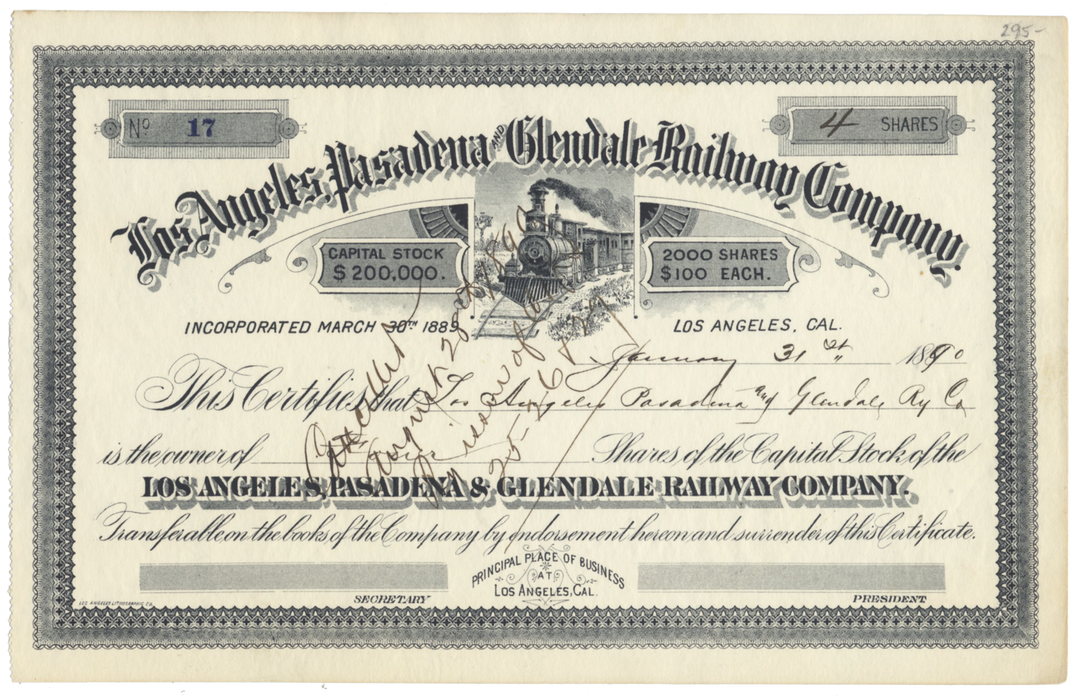
Los Angeles, Pasadena and Glendale Railway Company
- In stock
- Backordered, shipping soon
- Guaranteed authentic document
- Orders over $35 ship FREE to U. S. addresses
- Earn rewards points with every order
Product Details
| Company | Los Angeles, Pasadena and Glendale Railway Company |
| Certificate Type | Capital Stock |
| Date Issued | Partially issued, January 31, 1890 |
| Canceled | Yes |
| Printer |
Los Angeles Lithographic Co. |
| Signatures | NA |
| Approximate Size |
10 1/4" (w) by 6 1/2" (h) |
|
Product Images |
Show the exact certificate you will receive |
| Authentic | Yes |
| Additional Details | NA |
Historical Context
This line was known informally as the “Cross Road” because that was the surname of its prime mover, John Cross (1842-1911), a native of Michigan who was a captain in a Missouri cavalry unit the United States Army during the Civil War. Cross became a street railroad developer in Little Rock, Arkansas and Lexington, Kentucky. Lured to Los Angeles as so many were, he came to the city in 1883 and built a home, Palm Place, off 3rd Street just west of the Crown Hill area discussed in posts on this blog . Locally, he worked on a street railway in Santa Barbara and local lines such as the Los Angeles and Glendale Railroad (1887) and the Los Angeles Terminal Railroad (1890).
Joining him in the Los Angeles, Pasadena and Glendale project was his nephew, Albert Cross, among other investors and the company formed on March 30, 1889, issuing its stock in a total of $200,000 with 2000 shares at a par value of $100 each. The company then moved to build two lines, the main one into Pasadena up the Arroyo Seco, basically along where the Metro Gold Line runs today, and totaling 6.4 miles of standard-gauge tract and the second a 1.8 mile addition from Glendale, where the Los Angeles and Glendale terminated in March 1888, to Verdugo Park, in what is generally known as the Verdugo City area of an expanded Glendale.
There were a number of legal challenges to the firm as it worked quickly to secure rights-of-way, especially for the Pasadena line. The newly incorporated town of South Pasadena, for example, included residents and property owners, including the well-known Benjamin S. Eaton and his son, who sued over the plans of the line as it was to run right through town. Other suits were filed by ranchers in Pasadena, who were also not happy to deed over easements to the railway.
Despite these obstacles, the company persevered and was able to complete its lines, with the one to Pasadena opening in mid-March 1890. A dedication ceremony included the presence of Governor Robert Waterman and Lieutenant Governor Stephen M. White. Some 2,000 persons took part as steam-powered trains ran from the terminus near where the Arroyo Seco meets the Los Angeles River into Pasadena.
One of the outgrowths of the opening of the Los Angeles, Pasadena and Glendale Railway was that the Santa Fe’s control of charges in the northern San Gabriel Valley was challenged, leading to lower rates for fares and shipping. The railway was also touted as an easy way for residents of Los Angeles to access Pasadena and the San Gabriel Mountains, through the scenic route along the Arroyo Seco.
Cross, however, decided to effect a consolidation within nine months of opening and the Los Angeles and Glendale and Los Angeles, Pasadena and Glendale companies merged with the new Los Angeles Terminal Railway later in 1890.
Related Collections
Additional Information
Certificates carry no value on any of today's financial indexes and no transfer of ownership is implied. All items offered are collectible in nature only. So, you can frame them, but you can't cash them in!
All of our pieces are original - we do not sell reproductions. If you ever find out that one of our pieces is not authentic, you may return it for a full refund of the purchase price and any associated shipping charges.


